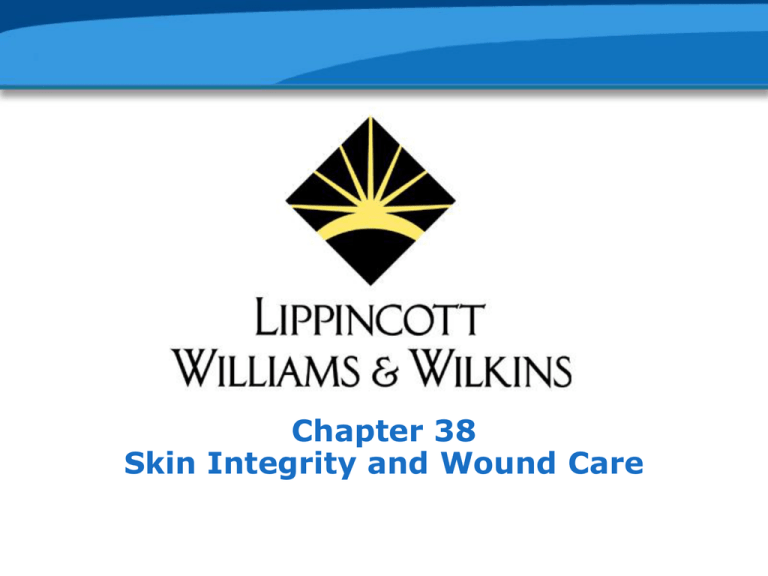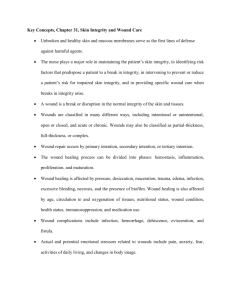Airgas template - Home - KSU Faculty Member websites
advertisement

Chapter 38 Skin Integrity and Wound Care Types of Wounds • Intentional or unintentional • Open or closed • Acute or chronic • Partial thickness, full-thickness, complex Principles of Wound Healing • Intact skin is the first line of defense against microorganisms. • Surgical asepsis is used in caring for a wound. • The body responds systematically to trauma of any of its parts. • An adequate blood supply is essential for normal body response to injury. • Normal healing is promoted when wound is free of foreign material. Principles of Wound Healing (continued) • The extent of damage and the person’s state of health affects wound healing. • Response to wound is more effective if proper nutrition is maintained. Phase of Wound Healing • Inflammatory • Proliferative • Remodeling Inflammatory Phase • Begins at time of injury • Prepares wound for healing – Hemostasis (blood clotting) occurs – Vascular and cellular phase of inflammation Proliferative Phase • Phase begins within 2 to 3 days of injury and may last up to 2 to 3 weeks. • New tissue is built to fill wound space through action of fibroblasts. • Capillaries grow across wound. • Thin layer of epithelial cells forms across wound. • Granulation tissue forms foundation for scar tissue development. Remodeling Phase • Final stage of healing begins about 3 weeks after injury to possibly 6 months. • Collagen is remodeled • New collagen tissue is deposited. • Scar becomes a flat, thin, white line. Factors Affecting Wound Healing • Age — children and healthy adults heal more rapidly • Circulation and oxygenation — adequate blood flow is essential • Nutritional status — healing requires adequate nutrition • Wound condition – specific condition of wound affects healing • Health status — corticosteroid drugs and postoperative radiation therapy delay healing Wound Complications • Infection • Hemorrhage • Dehiscence and evisceration • Fistula formation Psychological Effects of Wounds • Pain • Anxiety • Fear • Change in body image Wound Assessment • Inspection for sight and smell • Palpation for appearance, drainage, and pain • Sutures, drains or tube, manifestation of complications Presence of Infection • Wound is swollen. • Wound is deep red in color. • Wound feels hot on palpation. • Drainage is increased and possibly purulent. • Foul odor may be noted. • Wound edges may be separated with dehiscence present. Assessment of Wound Drainage • Serous • Sanguineous • Purulent Purposes of Wound Dressings • Provide physical, psychological, and aesthetic comfort • Remove necrotic tissue • Prevent, eliminate, or control infection • Absorb drainage • Maintain a moist wound environment • Protect wound from further injury • Protect skin surrounding wound Types of Wound Dressings • Telfa • Gauze dressings • Transparent dressings Color Classification of Open Wounds • R = red — proliferative stage of healing; reflect color of normal granulation • Y = yellow — characterized by oozing; need to be cleansed • B = black — covered with thick eschar; require debridement • Mixed wounds — contain components or RY&B wounds Types of Bandages • Roller bandages • Circular turn • Spiral turn • Figure-of-eight turn • Recurrent-stump bandage Types of Binders • Straight — used for chest and abdomen • T-binder — used for rectum, perineum, and groin area • Sling — used to support an arm Factors Affecting the Response to Hot and Cold Treatments • Method and duration of application • Degree of heat and cold applied • Patient’s age and physical condition • Amount of body surface covered by the application Effects of Applying Heat • Dilates peripheral blood vessels • Increases tissue metabolism • Reduces blood viscosity and increases capillary permeability • Reduces muscle tension • Helps relieve pain Effects of Applying Cold • Constructs peripheral blood vessels • Reduces muscle spasms • Promotes comfort Devices to Apply Heat • Hot water bags or bottles • Electric heating pads • Aquathermia pads • Heat lamps • Heat cradles • Hot packs • Moist heat • Sitz baths • Warm soaks Devices to Apply Cold • Ice bags • Cold packs • Hypothermia blankets • Moist cold Topics for Home Care Teaching • Supplies • Infection prevention • Wound healing • Appearance of the skin/recent changes • Activity/mobility • Nutrition • Pain • Elimination Factors Affecting Pressure Ulcer Development • Aging skin • Chronic illnesses • Immobility • Malnutrition • Fecal and urinary incontinence • Altered level of consciousness • Spinal cord and brain injuries • Neuromuscular disorders Mechanisms in Pressure Ulcer Development • External pressure compressing blood vessels • Friction or shearing forces tearing or injuring blood vessels Stages of Pressure Ulcers • Stage I — non-blanchable erythema of intact skin • Stage II — partial-thickness skin loss • Stage III — full-thickness skin loss; not involving underlying fascia • Stage IV — full-thickness skin loss with extensive destruction • Norton and Braden scales • Nursing history • Physical assessment Measurement of a Pressure Ulcer • Size of wound • Depth of wound • Presence of undermining, tunneling, or sinus tract Cleaning a Pressure Ulcer • Clean with each dressing change. • Use careful, gentle motions to minimize trauma. • Use 0.9% normal saline solution to irrigate and clean the ulcer. • Report any drainage or necrotic tissue. Dressing the Pressure Ulcer • Keep ulcer tissue moist and surrounding skin dry. • Place moist dressings only on the wound surface. • Use dressing that absorbs exudate but maintains moist environment. • Use skin sealant or moisture-barrier ointment on surrounding skin. • Secure dressing with the least amount of tape possible. • Use wet-to-dry dressings for debridement, when ordered. • Pack wound cavities loosely with dressing material.





